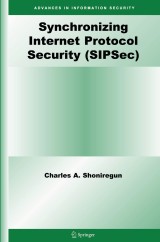Details

Synchronizing Internet Protocol Security (SIPSec)
Advances in Information Security, Band 34
|
96,29 € |
|
| Verlag: | Springer |
| Format: | |
| Veröffentl.: | 10.06.2007 |
| ISBN/EAN: | 9780387685694 |
| Sprache: | englisch |
| Anzahl Seiten: | 223 |
Dieses eBook enthält ein Wasserzeichen.
Beschreibungen
The open design of the Internet has not only opened many new opp- tunities for communications, but it has also opened many new avenues for attackers against organisations network and computing resources. This book is a critical investigation of the Internet Protocol Security (IPSec) based on combination of theoretical investigation and practical implementation, which provides an in-depth understanding of the IPSec framework. The bene?ts of IPSec were exploited while the delimiting factors cannot be ignored. Infor- tion security has become a major concern in recent times as more and more computers are being connected to the global Internet. With so much data tra- ferring over public networks, the risk of sensitive information has increased exponentially and the increase of Internet hosts continuously requires ad- tional security support. The IPSec may be used in three different security - mains: Virtual private networks, Application-level security, and Routing se- rity. It comprises of suite of protocols, which are developed to ensure that the integrity, con?dentiality and authentication of data communications over an IP network. The IPSec is predominately used in virtual private networks (VPNs). But when used in application-level security or routing security, the IPSec is not a complete solution and must be coupled with other security measures to be effective. As with other security systems, poor maintenance can easily lead to a critical system failure.
Research Overview and Conceptual Understanding of Internet Protocol Security (IPSEC).- Internet communication Protocols.- Internet Protocol Versions 4 (IPV4) and 6 (IPV6).- Implementations and Limitations of the IPSEC.- Synchronising Internet Protocol Security (SIPSEC) Model.- Discussion.- Conclusion.
<P>The open design of the internet has not only opened many new opportunities for communications, but it has also opened many new avenues for attackers against organizations network and computing resources. Information security has become a major concern in recent times, as more and more computers are being connected to the global internet. With so much data transferring over the public networks, the risk for sensitive information has increased exponentially, while the increase of internet hosts continually requires additional function support.</P>
<P><EM>Synchronizing Internet Protocol Security</EM> (SIPSec) focuses on the combination of theoretical investigation and practical implementation, which provides an in-depth understanding of the Internet Protocol Security (IPSec) framework. The standard internet protocol is completely unprotected, allowing hosts to inspect or modify data in transit. This book also identifies the security problems facing the internet communication protocols, the risks associated with internet connections, delimitations of the IPSec, and finally, a "Synchronisation of Internet Protocol Security (SIPSec)" model.</P>
<P><EM>Synchronizing Internet Protocol Security</EM> is designed for a professional audience composed of researchers and practitioners in industry. This book is also suitable for graduate-level students in computer science.</P>
<P> </P>
<P><EM>Synchronizing Internet Protocol Security</EM> (SIPSec) focuses on the combination of theoretical investigation and practical implementation, which provides an in-depth understanding of the Internet Protocol Security (IPSec) framework. The standard internet protocol is completely unprotected, allowing hosts to inspect or modify data in transit. This book also identifies the security problems facing the internet communication protocols, the risks associated with internet connections, delimitations of the IPSec, and finally, a "Synchronisation of Internet Protocol Security (SIPSec)" model.</P>
<P><EM>Synchronizing Internet Protocol Security</EM> is designed for a professional audience composed of researchers and practitioners in industry. This book is also suitable for graduate-level students in computer science.</P>
<P> </P>
First book that includes in-depth information on IPSecs IPSecs used in this book include a number of different algorithms and protocols to provide a cohesive security framework Includes an investigative case study regarding the vulnerabilities that impair IPSec and how to prevent this from occurring
<P>Synchronizing Internet Protocol Security (SIPSec) focuses on the combination of theoretical investigation and practical implementation, which provides an in-depth understanding of the Internet Protocol Security (IPSec) framework. The standard internet protocol is completely unprotected, allowing hosts to inspect or modify data in transit. This volume identifies the security problems facing internet communication protocols along with the risks associated with internet connections. It also includes an investigative case study regarding the vulnerabilities that impair IPSec and how this can be prevented from occurring and proposes a SIPSec Model.</P>


















